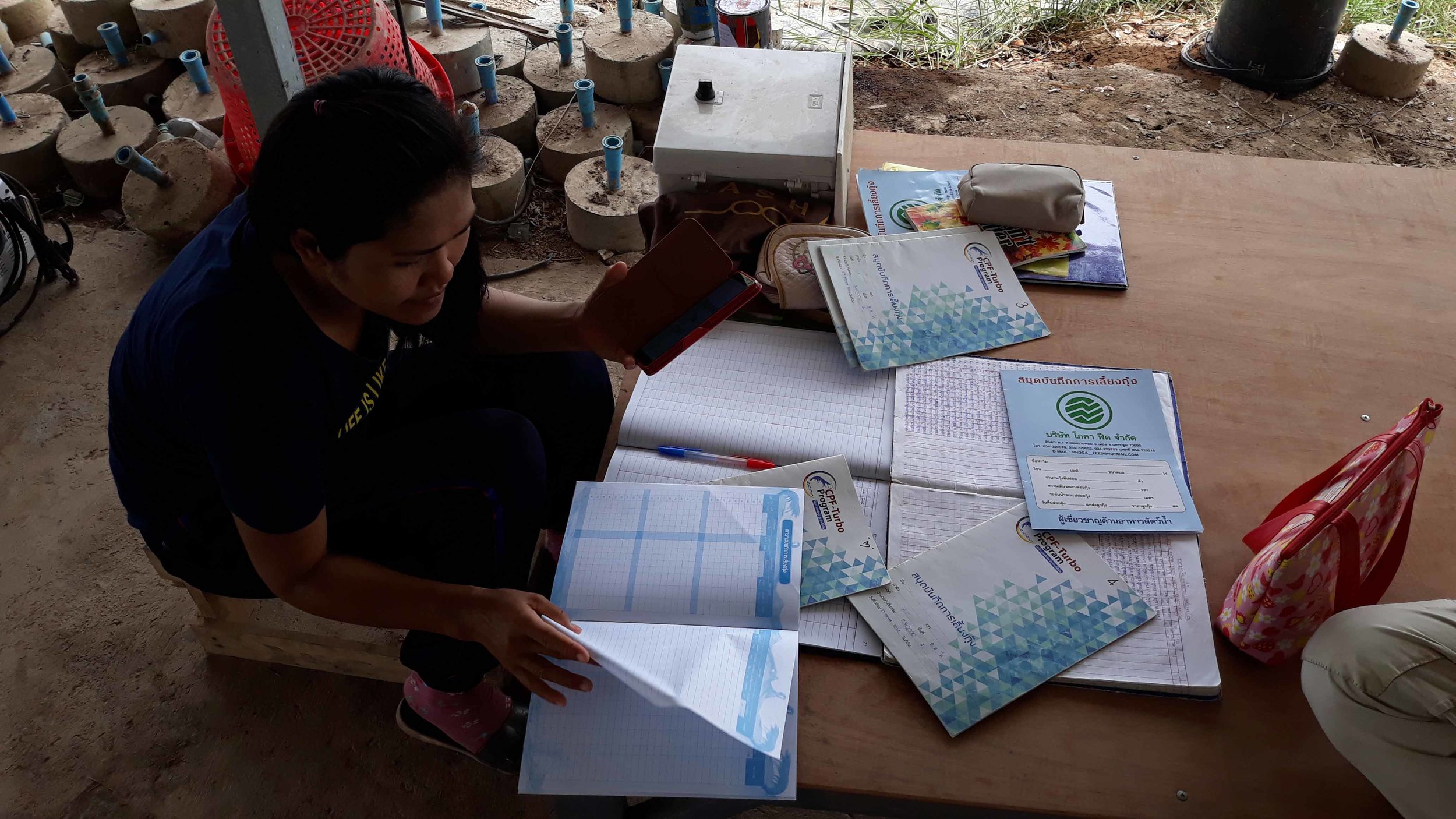Operations planning, management and communication tools
Production planning and management:
Production planning and management is the forecasting of the yield of shrimp crops given the amount of resources available (e.g. tanks, ponds, feed, manpower, equipment etc.) and adjusting of the input to ensure the harvest is as predicted. By measuring and monitoring the overall input into the system, farmers can monitor and manage the changes in conditions for each harvest. This helps them identify areas of improvement for greater efficiency and reduced waste and production costs. A simple, efficient, and organized system for recording the input, output, and associated costs helps farmers to achieve higher yields, smoother operations and profits.
Communication:
Communication regarding farm operation is most commonly done through verbal instructions, especially when there are varying levels of literacy among farm staff. There are generally some sort of written management/production plans on site, either on a fixed whiteboard or some sort of a log book. On more highly technical farms, our surveys found that chemical and mineral additions are usually managed through handwritten notes, and the feed schedules are mapped out on a whiteboard, as feeding plans are subject to frequent change.
Technology usage:
Very few farmers use laptops, though the use of instant messaging apps, like WhatsApp, Line, and WeChat, are more widespread. Specifically, our data shows that these apps are commonly used by managers and supervisors for data reporting and to alert others about abnormal shrimp health/pond conditions.
Below is a country comparison on farm operational planning, management and communication methods
data overview
| www.shrimpfarm.tech by HATCH | Indonesia | India | Ecuador | Thailand | Vietnam | China |
|---|---|---|---|---|---|---|
| Most common production and operation planning tools Intuition, pen & paper, supplier logbooks, custom printed spreadsheets or logbooks, laptop & Excel, Google Drive, custom integrated software, commercial farm management software, mobile app, complete IOT integrated app |
Custom printed spreadsheets, laptop & excel | Custom printed spreadsheets and custom logbooks | Custom printed spreadsheets or supplier logbooks | Custom printed spreadsheets or supplier logbooks | Supplier company logbooks | Pen & paper or laptop & Excel |
| Most common farm communication tools Strictly verbal in person, VHF radio, segmented whiteboards, custom printed spreadsheets, smart phone, commercial farm management app |
Segmented whiteboards, custom printed spreadsheets, smart phone | Stickley verbal or custom printed spreadsheets | VHF radio, custom printed spreadsheets, smart phone | Strictly verbal in person, custom printed spreadsheets, segmented whiteboards | Segmented whiteboards, strictly verbal in person | Segmented whiteboards and smart phone |
| Mobile Network Coverage Quality None, poor or good |
Poor | Good | Poor | Poor | Good | Good |
| Smart phone usage and instant messaging app | All staff, WhatsApp | All staff, WhatsApp | All staff | All staff, Line App | All staff, Zalo or Yellow App | All staff, WeChat App |
| Farm installed wireless internet Non, only in office, farm-wide network |
Only in office | None | Only in office | None | None | Only in office |
Summary
Although some farmers use customized software, few actually had the capacity to keep and maintain digital records of their operations. Farmers determine their daily tasks using visual observations, handwritten projections, and their intuition from a long history of farming experience. Those who lack such experience have limited information to decide on the appropriate course of action. More often than not, changes in in-situ conditions are not immediately addressed. Without real-time information on pond conditions, shrimp behavior, and equipment performance, inexperienced farmers resort to reactive farming with poorly-informed decision making. Ideally, farming decisions should be made according to a multitude of indicators as poor farm management mostly leads to poorer shrimp health and sub-optimal growth.
Innovation opportunities
It is no surprise that there are multiple opportunities for innovation within farm operations and communication systems. There is a demonstrated need for cheap, user-friendly, straightforward, and reliable management applications that are compatible with smartphones Empowering farmers with a compatible management system would enable them to make better informed decisions and forecast production performances.
Technology to report and forecast the following indicators: shrimp behaviour, shrimp health, nutritional requirements, water conditions, farm equipment, staff performance and inventory. On a larger scale, this would be more appropriate on an integrated mobile application and should also be flexible enough to fit individual farmer requirements and existing farm equipment. Most farms are situated in rural areas without reliable phone reception so we expect solutions to work independently and manage with intermittent signal disruption.
Since operational information is shared verbally, in writing or relayed via text or images, we hope to see solutions enabling farmers to organise and keep a historical record of data. This data can lead to better production protocols and forecasting. Image analysis of photos of handwritten notes, whiteboards and other documents can help to automate digitalization of farm records
As an added bonus, with better management and control enables farmers to track progress on various performance parameters and KPIs which can be useful in assessing insurance or financing. Any one or a combination of the above will help farmers to better plan, manage, and communicate tasks for successful farm operations and harvests.











